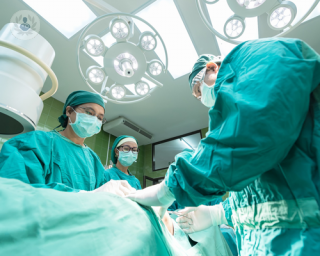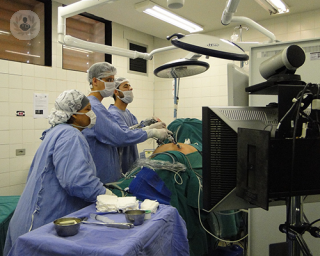Laparoscopy
Mr David McArthur - Colorectal surgery
Created on: 11-13-2012
Updated on: 08-01-2023
Edited by: Conor Dunworth
What is laparoscopy?
Laparoscopy is a minimally invasive surgical technique which allows the surgeon to operate without the need for deep or large incisions in the skin. This means the recovery period is generally shorter, there is less pain after the operation, and scarring is reduced significantly for the patient. This technique is also known as keyhole surgery.

Why is laparoscopy done?
Laparoscopy can be used to both treat and diagnose a range of conditions across specialties such as surgery, orthopaedic surgery, gynaecology, gastroenterology, and urology. Laparoscopy may be used in investigation, to check symptoms and attempt to reach a diagnosis, for example in cases of ovarian cysts, fibroids, pelvic inflammatory disease, and appendicitis. Laparoscopy can also be used to take a biopsy (a small sample of tissue) meaning it can be used to investigate certain cancers, e.g liver cancer, ovarian cancer, pancreatic cancer, and many more.
As a surgical technique, laparoscopy is especially useful as it allows for minimal scarring and a shorter recovery period, which is advantageous to the patient. Laparoscopy can be used as a surgical technique in many situations, such as:
- Weight loss surgery
- Removal of the gallbladder as a treatment for gallstones
- Removal of the appendix
- Repairing stomach ulcers
- Hysterectomy
- Treating ectopic pregnancy
- Removal of organs affected by cancer
How is laproscopy performed?
Laparoscopy is performed under general anaesthetic, which relaxes the muscles and reduces pain. The surgeon makes small incisions in the abdomen and inserts a laparoscope, which is a small camera attached to the end of a thin tube, allowing the surgeon to see inside the abdomen through a projection on a TV monitor in front of them.
The first incision is made in the navel and the abdomen will be inflated in order to make the organs easier to view. A second incision may also be made at the pubic hairline, as an additional opening for surgical instruments. The surgeon uses these small instruments to perform surgery, looking at the TV monitor for a clear view of the area they need to operate on.
The procedure normally takes around 30 to 60 minutes and patients are required to stay in the recovery room for an hour after the surgery is performed. You will be mointored by a nurse and can normally be discharged about four hours after surgery
How do you prepare for laparoscopy?
There are a few ways in which you can prepare for a laparoscopy. These are as follows:
- You should not eat or drink anything for 6-12 hours before the procedure.
- You should not smoke a few days before the prodedure takes place. Smoking can delay the healing process.
- You should remove any nail polish before surgery.
- You should not wear jewellery (wedding rings can be worn).
- You should wear loose-fitting clothing because you will experience some cramping and tenderness folllowing surgery.
- You should stop taking blood-thinning medicine a few days before surgery.
What tests are typically done before laparoscopy?
Before undergoing a laparoscopy, you may have to do some tests so that the doctor can gather information about your health. Some of the following tests may be performed:
- pathology report
- cytology slides
- tissue specimens
- lab work
- film reports
- previous X-rays from another facility
Some doctors may also request an ultrasound, CT scan or MRI scan.
Laparoscopy aftercare
As laparoscopy is a minimally invasive procedure, you can usually go home either on the same day or the day following surgery. Someone will need to accompany you home as you will be advised not to drive for the 24 hours following the procedure. You also cannot drink alcohol for 24 hours after surgery. We recommend these tips as aftercare following a laproscopy:
- You may remove the bandage the morning after surgery.
- Avoid strenuous activities such as jogging, weight lifting or aerobic exercise until your doctor approves these types of activities.
- Try to walk each day, as this will boost blood flow and prevent constipation and pnuemonia.
- Avoid lifting anything which may cause strain, such as heavy grocery bags, a backpack or dog food bags.
- You can shower 24 to 48 hours after surgery. You should wait to have a bath until 2 weeks following surgery, unless your doctor says otherwise. You should pat dry the wound.
- Don´t worry if your urine is green because a blue dye may have been used to check if the fallopian tubes are open.
- You may feel some bloating, cramps and shoulder cramps after surgery. These symptoms are nothing to worry about.
- Take regular naps as you may feel more tired than usual after the surgery.
Recovery from laparoscopy depends on the type of procedure performed. After diagnostic laparoscopy, for example, you may be able to resume normal activity after five days. After minor surgery, such as ulcer repair, normal activity may be resumed in around three weeks.
Major surgery, such as hysterectomy or organ removal (e.g kidney) typically takes longer – up to 12 weeks. Your surgeon or doctor will advise you on how to clean your stitches and keep wounds clean.
Expect to feel tired or somewhat drained after surgery for a few days, but this should pass as your body uses less and less energy as the recovery process goes on. If you experience any pain, you can take over-the-counter medication pain relief to reduce it.

What are the advantages of a laparoscopy?
There are several advantages of a laproscopy, making it more favourable than open surgery. Some advantages are as follows:
- small incisions
- reduced scarring/less wounds
- reduced infection rate
- a shorter hospital stay (around 2 nights)
- faster recovery time (around 2 to 3 weeks)
- less pain and bleeding following operation
However, some surgeons prefer to use traditional methods because a laproscopy has limitations (due to limited range of movement), it increases the risk of complications and sometimes has incomplete clearance.
What are the risks of laparoscopy?
Like most surgeries, a laparoscopy involves some risk. Some of the risks include:
- Hernia.
- Bleeding.
- Blood clots
- Peritoneal trauma.
- Inflammation or infection.
- Potential need for blood transfusion.
- Damage to internal structures including the stomach, bowel, bladder or ureter.
- Hypothermia is a risk because of increased exposure to cold, dry gases during insufflation.
- Trocar injuries- these types of injuries are produced when there is insertion into the abdominal cavity. Some include umbilical hernias, umbilical wound infections and abdominal wall hernias. These risks are more likely to affect people who have a previous abdominal surgeries or low BMI (body mass index).
What are the alternatives to laparoscopy?
Laparoscopy is a minimally invasive technique which is used as an alternative to traditional open surgery. Open surgery may be necessary in certain situations and your surgeon will speak to you regarding your options before making a decision as to which type of surgery will be performed.

















